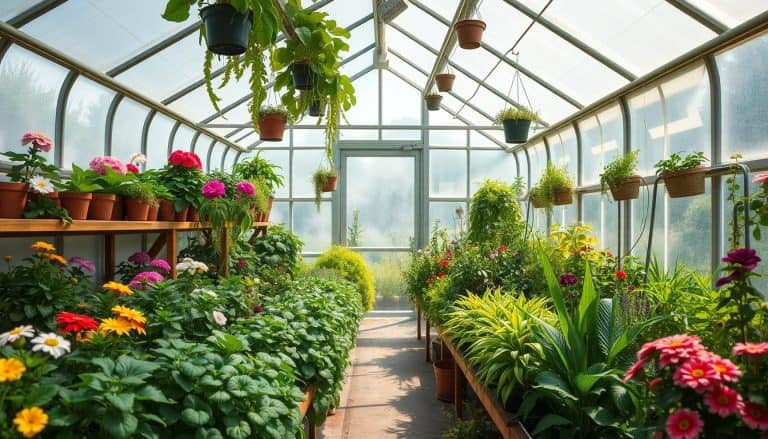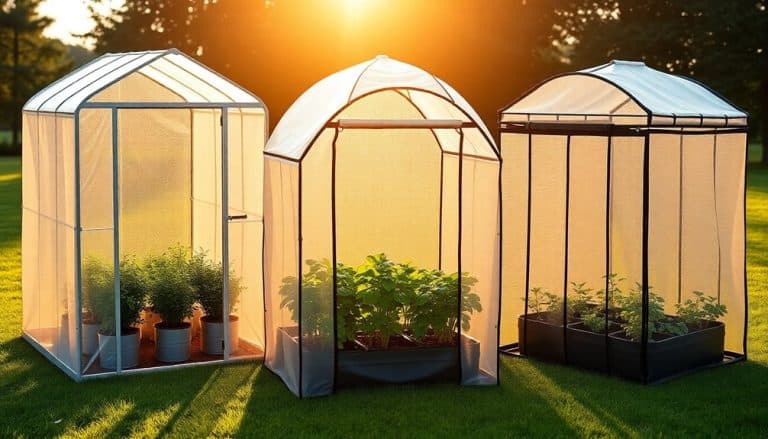This website contains affiliate links. Some products are gifted by the brand to test. As an Amazon Associate, I earn from qualifying purchases. The content on this website was created with the help of AI.
You’ll find reliable success growing leafy greens like spinach and kale in cooler temperatures below 45°F, while heat-loving stars such as tomatoes and peppers thrive between 75-95°F. For year-round production, focus on adaptable salad greens that flourish at 60-75°F with proper circulation. Mediterranean herbs like basil and oregano offer continuous harvests when planted successively every 3-4 weeks. Complement your greenhouse with flowering plants like geraniums and orchids, which add beauty while thriving in controlled conditions. Your greenhouse’s potential extends far beyond these foundational choices.
Key Takeaways
- Leafy greens like spinach, kale, and Swiss chard thrive year-round in greenhouse conditions between 45-75°F with proper ventilation.
- Heat-loving plants including tomatoes, peppers, and eggplants produce high yields in greenhouse temperatures of 75-95°F.
- Herbs such as basil, oregano, and thyme provide continuous harvests when maintained at 65-75°F with regular pruning.
- Citrus trees grown in 15-gallon containers offer year-round production of fragrant blooms and fruit in greenhouse environments.
- Flowering plants like geraniums, begonias, and fuchsias provide consistent blooms while tolerating varying greenhouse temperatures.
Essential Cool-Weather Greenhouse Plants

A well-planned cool-weather greenhouse enables you to grow hardy vegetables and ornamentals when outdoor temperatures drop below 45°F (7°C). Your primary focus should be on leafy greens like spinach, kale, and Swiss chard, which thrive in cooler conditions and provide continuous harvests throughout winter months.
You’ll find success with root vegetables such as carrots, beets, and turnips, which develop sweeter flavors in cool temperatures. Plant these in deep containers to accommodate proper root development. Cold-tolerant herbs including parsley, cilantro, and mint will also flourish, providing fresh seasonings year-round.
For ornamentals, consider growing pansies, snapdragons, and calendula, which produce vibrant blooms even in lower temperatures. These flowers not only add color but also serve as companion plants, attracting beneficial insects. Don’t overlook winter-hardy succulents and alpine plants, which require minimal heating costs due to their natural cold tolerance.
Maintain temperatures between 45-65°F (7-18°C) for ideal growth. Install thermal screens or bubble wrap for additional insulation, and use cold frames within your greenhouse to create microenvironments for particularly sensitive plants. Monitor humidity levels to prevent fungal issues common in cool, enclosed spaces. Use a high-pressure rated garden hose with up to 650 PSI capacity to ensure proper watering pressure for all your greenhouse plants.
Heat-Loving Summer Growing Stars

Many tropical and heat-loving plants thrive in summer greenhouse conditions, where temperatures can reach 75-95°F (24-35°C). You’ll find that tomatoes, peppers, and eggplants excel during this period, producing abundant yields when provided with proper ventilation and consistent moisture. Cucumbers and melons also perform exceptionally well, especially vining varieties that can maximize vertical growing space.
For spectacular blooms, you’ll want to include hibiscus, which produces large, colorful flowers throughout the season, and bougainvillea, which thrives in the intense heat. Orchids, particularly Phalaenopsis and Cattleya varieties, flourish in warm, humid conditions when positioned in filtered light. You can’t go wrong with tropical foliage plants like philodendrons, calatheas, and bird of paradise, which add stunning architectural elements to your greenhouse.
To guarantee success with these heat-loving plants, you’ll need to maintain humidity levels between 60-80% and provide adequate air circulation. Installing shade cloth at 30-50% density will protect sensitive plants from scorching, while maintaining prime growing temperatures. Remember to increase watering frequency and monitor for spider mites, which proliferate in hot, dry conditions. A temperature control system can help maintain optimal growing conditions throughout the hottest summer months.
Herbs for Continuous Harvest
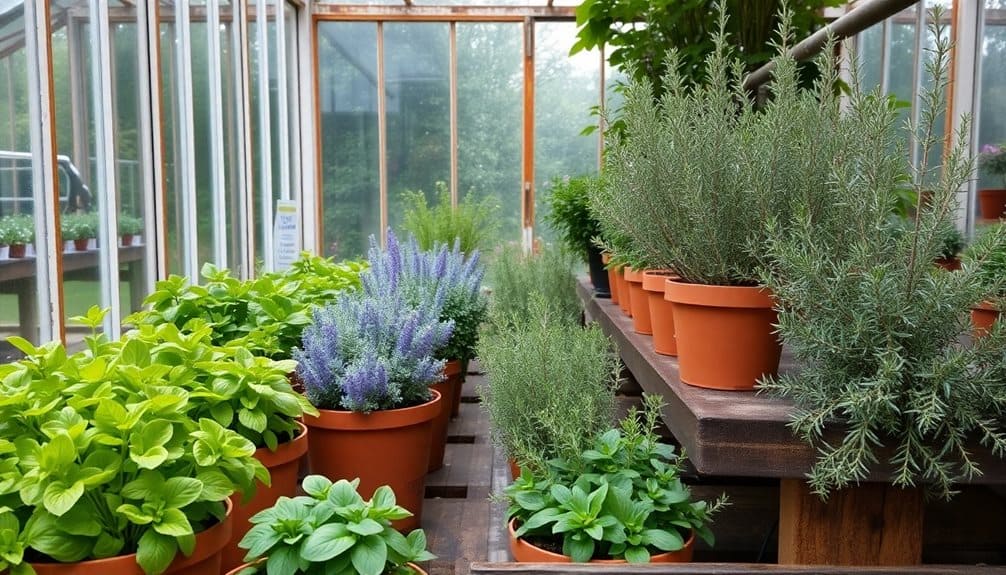
Growing herbs in your greenhouse sets you up for a perpetual supply of fresh seasonings throughout the year. Focus on high-yield varieties like basil, oregano, thyme, and mint, which respond well to regular harvesting and will continue producing new growth. You’ll need to maintain temperatures between 65-75°F (18-24°C) for ideal growth.
Plant your herbs in well-draining containers at least 6 inches deep, using a soil mix specifically formulated for herbs. Space them 12 inches apart to allow for proper air circulation and growth. Rosemary and sage require less frequent watering, while basil and cilantro need consistent moisture. You’ll maximize production by harvesting just above leaf nodes, which stimulates branching.
To guarantee continuous harvest, implement succession planting every 3-4 weeks for short-lived herbs like cilantro and dill. Perennial herbs such as thyme and oregano will produce steadily when trimmed regularly. Install adjustable shelving to create microclimates – place heat-loving herbs like basil on upper shelves, while mint and parsley thrive in cooler, lower positions. Monitor humidity levels, maintaining 50-60% to prevent fungal issues while supporting robust growth. Switching to a hydroponic growing system can accelerate herb growth by up to 300% compared to traditional soil methods.
Year-Round Salad Greens

Fresh salad greens can flourish year-round in your greenhouse with proper planning and environmental control. You’ll need to maintain temperatures between 60-75°F (15-24°C) and guarantee proper air circulation to prevent fungal issues. Start with proven performers like butter lettuce, arugula, spinach, and mesclun mixes, which adapt well to greenhouse conditions.
Implement succession planting by sowing new seeds every 2-3 weeks to maintain continuous harvests. You’ll want to use shallow trays with well-draining potting mix and space plants according to mature size requirements. Most leafy greens need 4-6 hours of direct sunlight daily, though you can supplement with grow lights during shorter winter days.
Monitor soil moisture carefully; greens prefer consistently moist but not waterlogged conditions. You’ll achieve ideal results using a drip irrigation system with timer controls. Feed plants with a balanced, water-soluble fertilizer every 2-3 weeks, reducing to monthly during winter. Harvest outer leaves regularly while leaving centers intact to encourage continued growth. Watch for common greenhouse pests like aphids and whiteflies; introduce beneficial insects or use organic pest controls when needed. Installing full-spectrum LED lights can support photosynthesis and enhance growth during all seasons while reducing energy costs by up to 80%.
Best Greenhouse Flowers
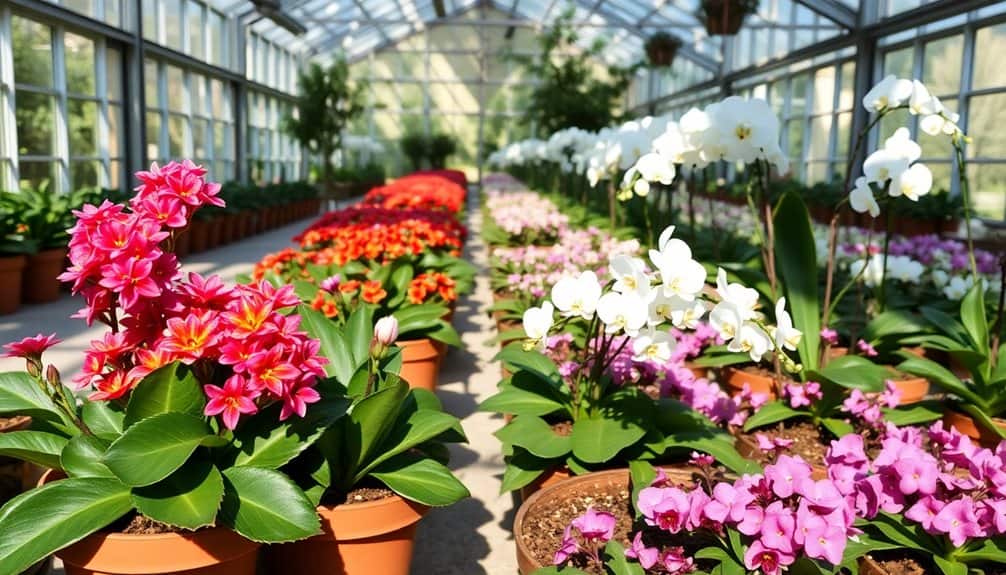
Colorful blooms can brighten your greenhouse throughout the seasons when you select the right flowering plants. The most reliable year-round greenhouse flowers include fuchsias, which thrive in partial shade and produce pendant-shaped blooms, and geraniums (Pelargonium), offering consistent color in well-lit conditions. You’ll find begonias particularly adaptable, especially the tuberous varieties that flower from spring through fall.
For winter blooming, you can’t go wrong with cyclamen, which prefer cooler temperatures between 50-65°F. Orchids, particularly Phalaenopsis and Cymbidium varieties, will flourish in humid greenhouse conditions, producing spectacular blooms for weeks. African violets provide continuous flowering when given proper light and consistent moisture levels.
To maximize your greenhouse’s flowering potential, incorporate climbing plants like jasmine and bougainvillea along support structures. These vertical growers offer abundant blooms while efficiently utilizing space. For best results, maintain temperatures between 60-75°F during the day and guarantee proper ventilation. You’ll need to adjust watering schedules seasonally and provide appropriate fertilization during active growth periods to sustain continuous blooming cycles.
Maintaining ideal humidity levels between 50-70% will help ensure your greenhouse flowers thrive and produce vibrant blooms consistently.
Container Plants for Greenhouse Success
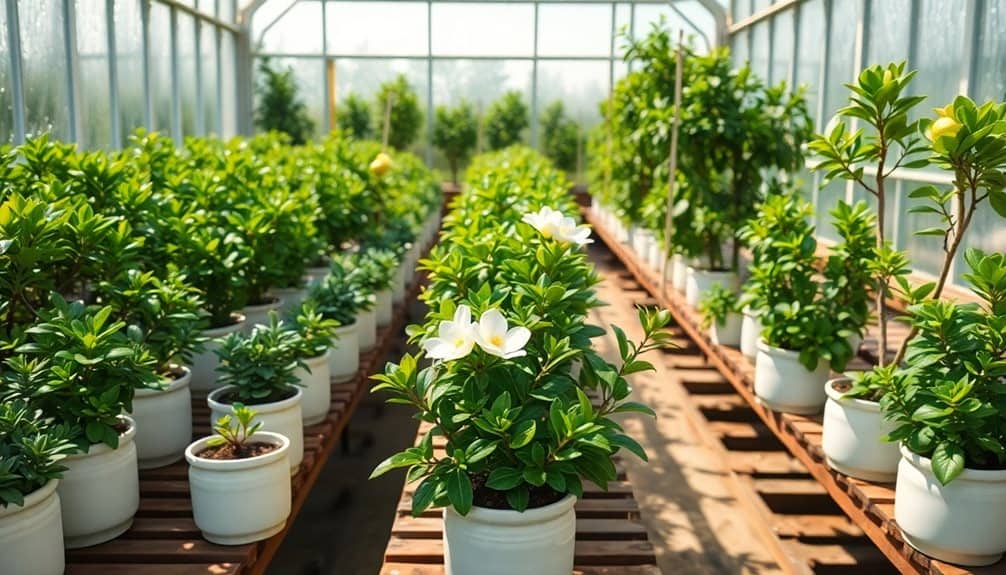
Successful container gardening in your greenhouse starts with selecting the right vessels and matching them to appropriate plants. You’ll need containers with adequate drainage holes and sufficient depth for root development. Clay pots offer excellent breathability but dry out quickly, while plastic containers retain moisture longer and work well for moisture-loving specimens. Consider using fabric grow bags for plants that benefit from air pruning of roots.
Select plants that thrive in contained environments and match their mature size to your container dimensions. Mediterranean herbs like rosemary and sage excel in terra cotta, while tropical plants prefer plastic pots that maintain consistent moisture levels. Always use high-quality potting mix specifically formulated for container growing.
- Watch your citrus trees burst with fragrant blooms and colorful fruit in 15-gallon containers
- Experience the satisfaction of harvesting fresh herbs year-round from 6-inch pots
- Delight in cascading cherry tomatoes trailing from hanging baskets
- Marvel at the vibrant colors of compact pepper varieties thriving in 5-gallon containers
Remember to group plants with similar water and light requirements together, and position containers to maximize air circulation and light exposure.
Frequently Asked Questions
What Temperature Settings Should I Maintain in My Greenhouse During Different Seasons?
Did you know 75% of greenhouse growers struggle with temperature management? You’ll want to maintain 65-75°F (18-24°C) during spring and fall days, dropping to 55-65°F (13-18°C) at night. In summer, keep temperatures below 85°F (29°C) using ventilation and shade cloth. During winter, don’t let temperatures fall below 45°F (7°C), and aim for 60-65°F (16-18°C) during daylight hours.
How Do I Prevent Common Greenhouse Pests Without Using Harsh Chemicals?
You’ll find several effective natural pest control methods for your greenhouse. Install fine mesh screens on vents and openings to block flying insects. Introduce beneficial insects like ladybugs and praying mantises to combat aphids and caterpillars. Use sticky traps to monitor and catch flying pests. Apply neem oil spray for broad pest control, and maintain proper air circulation to prevent fungal issues. Regular plant inspection helps catch problems early.
What Type of Greenhouse Material Is Best for My Climate Zone?
Even before Edison lit up our world, greenhouse materials mattered for growing success. You’ll need to match your climate zone’s challenges with the right covering. For hot regions, choose polycarbonate panels with UV protection and heat-diffusing properties. In cold zones, opt for double-wall polycarbonate or glass for superior insulation. Coastal areas benefit from acrylic panels that resist salt spray, while windy regions require reinforced glass or rigid twin-wall materials.
How Often Should I Clean and Sterilize My Greenhouse Equipment?
You’ll need to clean and sterilize your greenhouse equipment at least twice yearly – before spring planting and after fall harvest. Sanitize tools weekly with a 10% bleach solution or 70% alcohol. Disinfect pots, trays, and benches between crop rotations. Daily remove plant debris and sanitize pruning tools between each use to prevent disease spread. Monitor irrigation systems monthly and clean filters regularly.
Can I Use Artificial Lighting to Supplement Natural Light in Winter?
You can effectively supplement winter light with LED grow lights or high-pressure sodium (HPS) lamps. Position your lights 12-18 inches above plants and run them for 12-16 hours daily. LED systems offer energy efficiency and customizable spectrums, while HPS provides intense, full-spectrum light. You’ll need 20-40 watts per square foot, depending on your plants’ requirements. Install timers to maintain consistent photoperiods and prevent plant stress.


